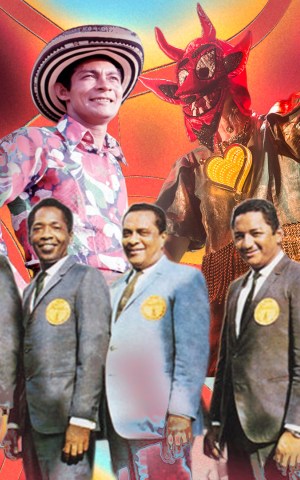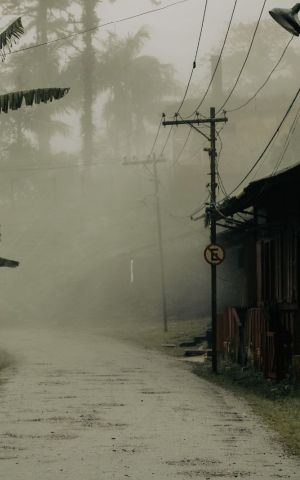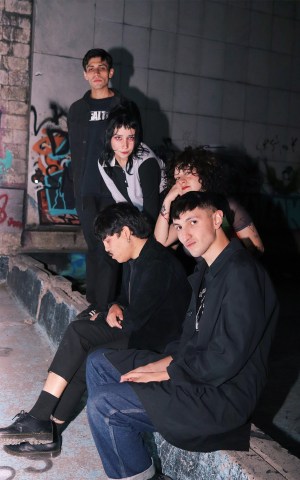The Mess is a new column from journalist Richard Villegas, who has been reporting on new, exciting sounds flourishing in the Latin American underground for nearly a decade. As the host of the Songmess Podcast, his travels have intersected with fresh sounds, scene legends, ancestral traditions, and the socio-political contexts that influence your favorite artists. The Mess is about new trends and problematic faves whilst asking hard questions and shaking the table.
We’re going there. We’re talking about it. Even if things get a little messy.
In the game of media, a narrative is everything. I’ve been thinking about this a lot in the wake of Bad Bunny’s excellent sixth LP, DeBÍ TiRAR MáS FOToS, with its loving, nuanced embrace of traditional Puerto Rican rhythms like plena, bomba, and salsa. The project has been touted as a long-awaited salsa revival, an ambition shared by Rauw Alejandro’s recent Cosa Nuestra LP, though he seemed more preoccupied with evoking canonical aesthetics than expanding the songbook. A similar conversation lingers around Rosalía and Karol G, celebrated for “rescuing” merengue with the glossy hits “Despechá” and “Si Antes Te Hubiera Conocido,” and in the española’s case, leading some misguided fans to claim she invented merengue electrónico. Rest assured, this won’t be a rant about cultural appropriation and ethno-musical ownership — valid conundrums think-pieced ad nauseam. I am, however, interested in dissecting the trendy revival of music that never actually died and how the Latin American underground spearheads these roots-curious movements long before the mainstream takes notice.
“I’ve never agreed with the storyline that we’re rediscovering or reviving tropical music. This isn’t some archeological dig; we’re not Indiana Jones,” says producer and multi-instrumentalist Felipe Orjuela, known for his innovative use of cumbia at Colombian label In-Correcto. Noting the discursive work of tropi-cannibanilsts like Frente Cumbiero and Meridian Brothers, and flanked by percussive rising stars La Perla and Conjunto Media Luna, Orjuela poignantly exults the omnipresence of traditional tunes. “My grandfather, my dad, and I danced to the same records,” he adds. “This music is very much alive and has been around our entire lives, in the city, in the countryside, and even at funerals.”

So, if tropical music permeates quotidian Latin American life, why is everyone suddenly looking inward? First, consider how reggaeton, K-pop, and Anglo-electropop sound increasingly similar, as producers and artists cross over to expand their respective audiences. Capitalism and globalization have fostered sonic homogenization and fatigue in many of these fandoms, and some of my colleagues, including Colombian journalist Santiago Cembrano and Venezuelan YouTube critic Doble R, argue the next big wave in music will be specific explorations of autochthonous identity. They cite the anthropological country of Beyoncé’s Cowboy Carter, the smattering of West Coast hip-hop subgenres on Kendrick Lamar’s GNX, and the meticulous Argentine idiosyncrasies of rapper Mir Nicolás’ SP.I.
I would add that the advent of corridos tumbados in Mexico and the U.S., the barrage of avant-flamenco artists pouring out of Spain, Brazil’s sertanejo upswing, and noisy weirdos experimenting with Chilean folk further highlight a zeitgeist shift. It seems a growing number of consumers would rather shop local and celebrate their own cultures than be duped into more generic, label-made playlist music distilled from trends in the Global North. I’ve previously expounded on these critiques when talking about Shakira’s latest LP and Latin American R&B, disco, and soul, but for now, let’s keep the lens on tropical sounds.
We’re [not] rediscovering or reviving tropical music. This isn’t some archeological dig; we’re not Indiana Jones… This music is very much alive and has been around our entire lives, in the city, in the countryside, and even at funerals.
“Merengue is part of our country’s DNA, even when its popularity fluctuates,” says Dominican trio Mula, a beacon of Afro-Caribbean experimentation and cornerstones of an alt-fusion scene, which also includes La Marimba, Xiomara Fortuna, and Riccie Oriach. Despite Mula’s futurist reputation, their forthcoming album, ETERNA, strives for timelessness, banking on the cross-generational appeal of merengue and Dominican tambora even when hybridized with techno and reggaeton. “Many subgenres have resurged, like merengue de calle and perico ripiao in El Cibao,” they add. “El Rubio Acordeón and El Blachy achieved a level of popularity comparable to the biggest dembow stars, demonstrating that merengue is resilient and still evolving.”

Perhaps the culture perceives a revival of these genres because our current generation of pop idols is exposing younger fans to music once synonymous with their parents’ antiquated tastes. Salsa icons Willie Colón, Rubén Blades, and Grupo Niche are constantly on tour, and while good music will always be immortal, for audiences in 2025, the messages behind “Pedro Navajas” and “El Gran Varón” may not resonate as powerfully as, say, Bad Bunny’s “La Mudanza.” Of course, the underground also brings socially charged tales to the forefront, and in Puerto Rico, the plena and salsa quartet Chuwi create rallying cries around land protection and animal rights. In Colombia, salsa became an infinitely pliable medium that democratized storytelling, fusing with rock (La-33), cantos from the Pacific Coast (Los Nemus del Pacífico), and an exciting mix of house and hip hop called salsa choke (Cali Flow Latino).
“Colombia es un pueblo de salsa, in no small part due to its proximity to the Antilles, but also soaking up influence from North America,” says La Pambelé, the Bogotá-based ensemble bringing salsa dura to clubs around the country. While their 2021 debut 1er Round was directly influenced by the New York salsa wave of the 1970s, their latest LP, Nací Mestizo, pays homage to Colombian salsa combos like La Protesta de Colombia, Los Afroins, and Onda Panamericana. “La Pambelé [tries] to preserve classic sounds while infusing a current vision,” they add, “Sharing stories happening in the streets and el barrio, which has always been the voice of salsa.”
“Cumbia plays all over Costa Rica, and it’s finally considered ‘cool’ in the capital,” reflects singer-songwriter and producer F.A.V., underscoring the history of classist marginalization behind many of these tropical genres. Putting a colorful, genderfluid spin on guapachoso sounds, the performer made a splash curb stomping bigots on the underground hit “No Hablo Con Fachos,” most recently teaming up with producer Tino Amor for the head-over-heels earworm, “Cute.” “Homegrown cumbia artists like Los Hicsos, Kalúa, and Calle 8 are still very popular,” he adds, “Though most of the cumbia that plays in my country comes from Mexico and Colombia.”

Cumbia, merengue, and salsa are enormously popular across Central America, but a lack of financial resources, media outlets, and label infrastructure within the region keeps the spotlight on the usual hubs of Miami, New York, and Mexico City. It’s no shade to anyone — the industry naturally gravitates to metropolitan centers with large audiences and cash flow. But it also explains why the myth of the revival proliferates when new trends emerge in these specific epicenters.
“I understand why someone more attuned to the mainstream might say, ‘Wow, nobody was making this music, and now it’s playing on the radio!’” chuckles Orjuela. “But getting on the radio takes money. All this music has been around forever, and it keeps coming. It’s just that many of us don’t have the money to make it into your homes.”




